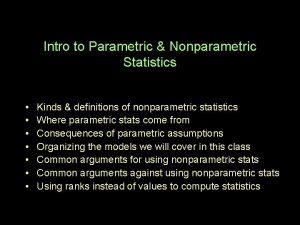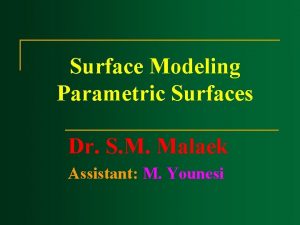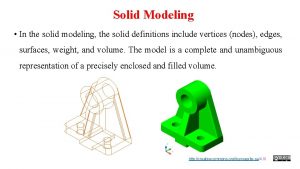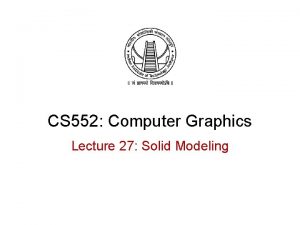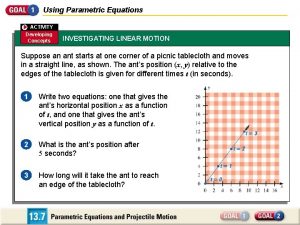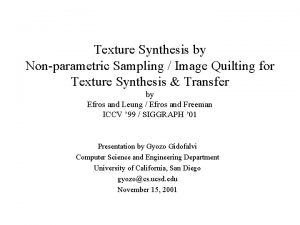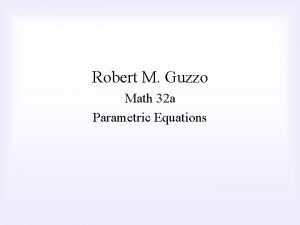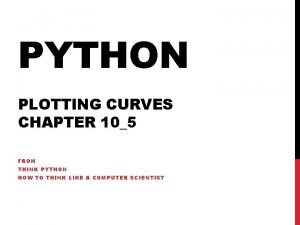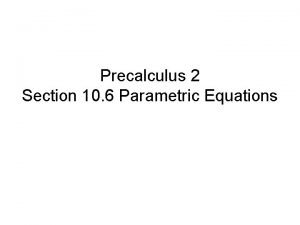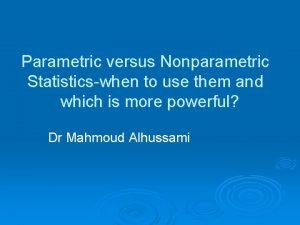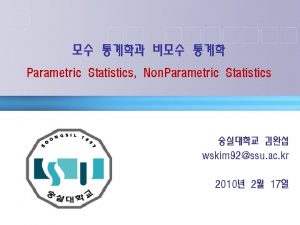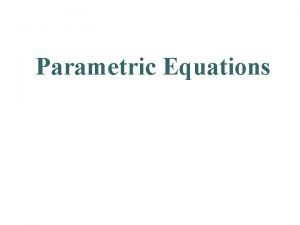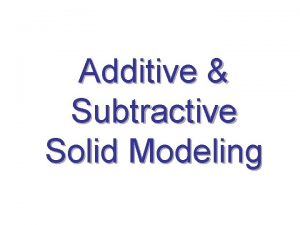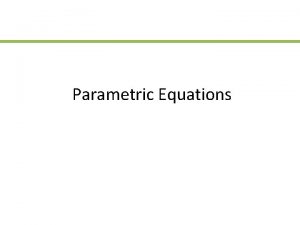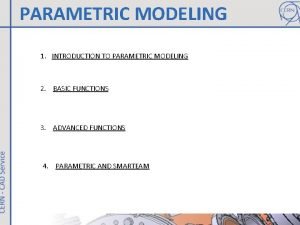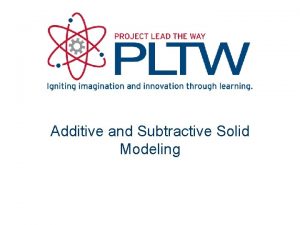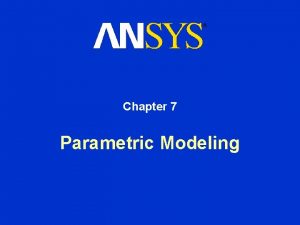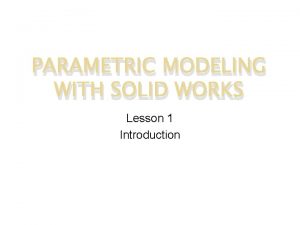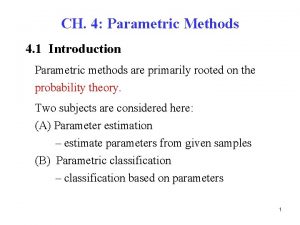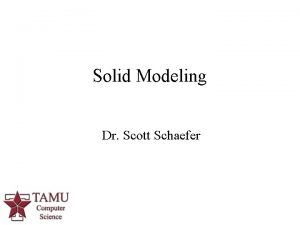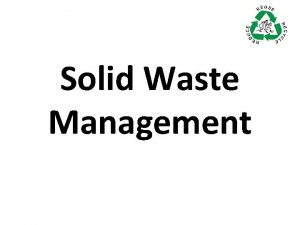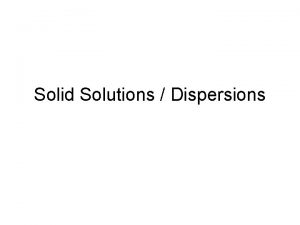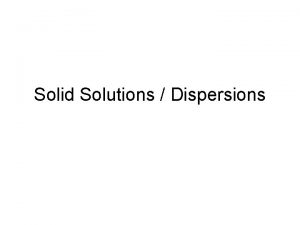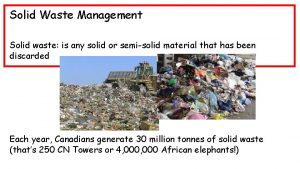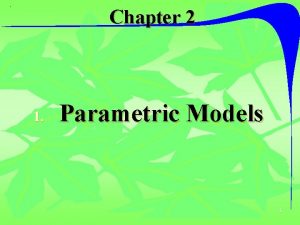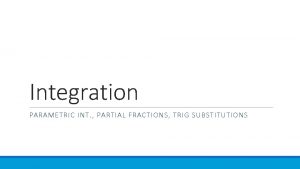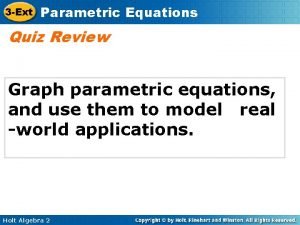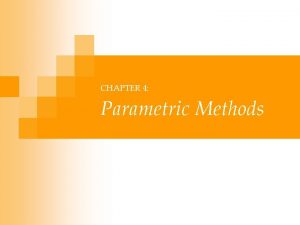Introduction to Solid Modeling Parametric 3 D Modeling




























- Slides: 28

Introduction to Solid Modeling Parametric (3 D) Modeling Ken Youssefi Introduction to Engineering, E 10. 1

Why do we need 3 D (digital) model? • 3 D models are easier to visualize and interpret. • 3 D models can be used to perform engineering analysis, finite element analysis (stress, deflection, thermal…. . ) and motion analysis • 3 D models can be used directly in manufacturing, Computer Numerical Control (CNC). • Less expensive than building a physical model. • 3 D models can be altered easily, create more concepts • Can be used for presentations and marketing. Ken Youssefi Introduction to Engineering, E 10. 2

Old designs - geometric New designs - freeform Ken Youssefi Introduction to Engineering, E 10. 3

Thermos Radio Coffee Press Ken Youssefi Mechanical Engineering Dept. 4

Freeform shapes Hull design Ken Youssefi Mechanical Engineering Dept. 5

Perform Engineering Analysis on Digital Model Using Finite Element Analysis (FEA) • Stress and deflection analysis • Thermal analysis (temp. distribution) • Dynamic analysis (vibration, fatigue, impact, . . ) • Drop test • Non-linear analysis Mesh element 10 -node Quadratic Ken Youssefi Introduction to Engineering, E 10. 6

Motion Analysis and Animation Ken Youssefi Mechanical Engineering Dept. , 7

Computer Aided Manufacturing Computer Numerical Control (CNC) CNC machine -Turning Center) Ken Youssefi Introduction to Engineering, E 10. CNC machine -Milling 8

CNC Face , 3 -axis Ken Youssefi Mechanical Engineering Department 9

Clicker Question 1 – A digital model (prototype) is created and used for what reason? a) Engineering analysis b) Manufacturing automation c) Less expensive than physical prototype and easier to modify d) Marketing and presentation e) All of the above Ken Youssefi Introduction to Engineering, E 10. 10

Creating Solid Models Parametric Modeling Concept • Parametric is a term used to describe a dimension’s ability to change the shape of model geometry if the dimension value is modified. • Feature-based is a term used to describe the various components of a model. A part can consist of various types of features such as holes, grooves, fillets, and chamfers. • Parametric models are featured-based, solid modeling design programs: Solid. Works, Creo (PTC), Inventor & Fusion 360 by Autodesk, Unigraphics, Catia, …. . Ken Youssefi Introduction to Engineering, E 10. 11

Sketching and Features When discussing the mind-set needed for working with parametric modelers, three topics need to be expanded: Sketching, Dimensioning and Features Sketching • Take the word sketch literally. A sketch should be just that, a sketch. • When sketching it is not necessary to create geometry with accuracy. Lines, arcs, and additional geometry need not be created with exact dimensions in mind. Dimensioning When dimensions are added, the sketch will change size and shape. This is the essence of Parametric Modeling. Ken Youssefi Introduction to Engineering, E 10. 12

Sketching and Features Ø Create a 2 D sketch and dimension it Ø Create a feature from the sketch by extruding, revolving, sweeping, and lofting. 2. 75 2. 5 1. 0 . 75. 25 Extruded feature Ken Youssefi Introduction to Engineering, E 10. Revolved feature 13

Creating Solids - Sweep A Sweep feature requires a profile and a path. The profile will follow the path to create the solid. Profile (section) Path (guide) Ken Youssefi Introduction to Engineering, E 10. Sweep feature 14

Creating Solids – Loft (different profiles) Round profile Square profile Round profile • Sections (profiles) do not have to be sketched on parallel planes • All sections must be either closed or open Ken Youssefi Introduction to Engineering, E 10. 15

Creating Features from Sketches Loft in Solid. Works Ken Youssefi Introduction to Engineering, E 10. 16

Design Intent • In parametric modeling, dimensions control the model. • Design intent is how your model will react when dimension values are changed. Ken Youssefi Introduction to Engineering, E 10. 17

Design Intent The drawing shows the intent of the designer that the inclined plane (chamfer) should have a flat area measuring 2. 5 inches and that it should start at a point 1. 25 inches from the base of the drawing. These parameters are what the designer deemed significant for this model. Line not dimensioned 2. 50 1. 25 4. 00 Remember that the placement of dimensions is very important because they are being used to drive the shape of the geometry. If the 2. 5 in. vertical dimension increases, the 2. 5 in. flat across the chamfer will be maintained, but its angle will change. Ken Youssefi Introduction to Engineering, E 10. 18

Design Intent In this drawing, what is important to the designer is the vertical location and horizontal dimension of the chamfer, rather than the flat of the chamfer. Line not dimensioned 2. 125 2. 50 1. 25 4. 00 1. 75 In the last drawing, the designer calls for a specific angle for the chamfer. In this case the angle of the chamfer should be dimensioned. Ken Youssefi Introduction to Engineering, E 10. 30. 0 O 2. 50 Line not dimensioned 4. 00 19

Design Intent Ken Youssefi Introduction to Engineering, E 10. 20

Parametric Modeling The true power of parametric modeling shines through when design changes need to be made. The design modification is made by simply changing a dimension. Pattern: 8 Holes Æ 30 10 60 15 Since the counterbore is associated with the top surface of the ring, any changes in the thickness of the ring would automatically be reflected on the counterbore depth. Ken Youssefi Introduction to Engineering, E 10. 21

Clicker Question 2 – The solid model shown below (paper clip) was created by what feature making technique? a) Loft b) Sweep c) Revolve d) Extrude e) Fillet Ken Youssefi Introduction to Engineering, E 10. 22

Applied Feature ØApplied feature does not require a sketch. Ø It is applied directly to the model. ØFillets and chamfers are very common applied features. Ken Youssefi Introduction to Engineering, E 10. Chamfer Fillet 23

Applied Features Shell – hollowing out a solid Ken Youssefi Introduction to Engineering, E 10. 24

Applied Features - Patterns Linear (rectangular) pattern Ken Youssefi Introduction to Engineering, E 10. 25

Applied Features - Patterns Linear (rectangular) pattern 1. Select direction 1 and 2 3. Select # of features in dir. 1 and 2 2. Select spacing in dir. 1 and 2 4. Select feature to pattern Ken Youssefi Introduction to Engineering, E 10. 26

Applied Features - Patterns Circular (polar) pattern 1. Select axis of rotation 3. Select # of features 2. Select spacing between features 4. Select feature to pattern Ken Youssefi Introduction to Engineering, E 10. 27

Clicker Question 3 – What 3 D modeling command would be easier to used to create the object (bowling pin) shown below? a) Chamfer b) Sweep c) Pattern d) Extrude e) Loft Ken Youssefi Introduction to Engineering, E 10. 28
 Univariate analysis tests
Univariate analysis tests Parametric test and non parametric test
Parametric test and non parametric test Parametric and non parametric algorithms
Parametric and non parametric algorithms Parametric
Parametric Surface modelling in cad
Surface modelling in cad Role modeling theory
Role modeling theory Relational modeling vs dimensional modeling
Relational modeling vs dimensional modeling Solid
Solid Solid examples
Solid examples _____ defines how solid a color appears.
_____ defines how solid a color appears. Crystalline or amorphous
Crystalline or amorphous Solve example
Solve example Covalent network solid vs molecular solid
Covalent network solid vs molecular solid Polycrystalline solids
Polycrystalline solids Crystalline solids
Crystalline solids Crystalline solid and amorphous solid
Crystalline solid and amorphous solid Anisotropic
Anisotropic When a solid completely penetrates another solid
When a solid completely penetrates another solid Interpenetration of solids
Interpenetration of solids What is sifting in separating mixtures
What is sifting in separating mixtures Linear motion equations
Linear motion equations Texture synthesis by non-parametric sampling
Texture synthesis by non-parametric sampling Parametric equations word problems
Parametric equations word problems Matplotlib parametric plot
Matplotlib parametric plot Parametric equations precalculus
Parametric equations precalculus Cramers v interpretation
Cramers v interpretation Wskim
Wskim Parametric insurance nat cat
Parametric insurance nat cat Cycloid equation cartesian
Cycloid equation cartesian



